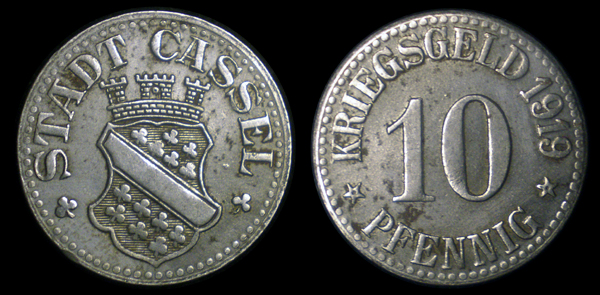
STADT CASSEL (GERMAN) 10 PFENNIG 1919
L- 75.5 City of Cassel (Hesse-Nassau) Iron 10 Pfennig Coin Depicting Town Coat of Arms
This iron 10 pfennig coin was issued by the City of Cassel and depicts the city coat of arms. On the reverse it says Kriegsgeld which literally translates as 'War Money'. Coins like this one were common and meant to be used as small change.
Cassel is a German town located on the Fulda river in north Hesse. In 1926 the town officially changed the spelling of its name to Kassel. This area was long inhabited in ancient times by the Chatti, a German tribe whose fortified Castellum Cattorum may be the source of the towns name. By the time it is first mentioned, it was a river fortification called Chasella.
By the 16th century, Cassel was a part of the Landgraviate of Hesse. When Hesse was divided between several sons, Cassel became the capitol of the newly created Landgraviate of Hesse-Cassel. To help raise revenues the Landgraff of Hesse-Cassel is known to have sold mercenary services to the British to fight in the American Revolution (Hessians). It was around this time that Cassel became a protestant haven spurring the Landgraff to fortify the city in defenses for protection.
By 1803 the landgraviate was elevated to a principality and its ruler became a Prince-elector of the Holy Roman Empire. Soon after it was annexed by Napoleon. In 1807 it became the capitol of the short-lived Kingdom of Westphalia under the rule of Jerome, brother of Napoleon, only to be restored as an electorate again in 1813. Having sided with Austria against Prussia in the Austro-Prussian war, the principality and Cassel were annex by Prussia after Austria's defeat. The principality ceased to exist and Cassel became a part of the newly created Prussian province of Hesse-Nassau.
By the early 20th century Cassel had developed into a major industrial center and a major railway, road, and river junction. With its growing industry the city expanded as did the population. Cassel's healthy businesses and industry would help fuel the German war effort in World War I.
In 1926 the spelling of the towns name was changed to Kassel and by 1935, under national socialist rule, Hesse-Nassau was split into two provinces, Nassau and Kurhessen. Kassel was the capitol of Kurhessen as well as the headquarters for the 9th military district. It also housed a sub camp of the Dachau concentration camp providing forced labor to industry in the area. Because of this Kassel was a target of allied bombing and on October 22, 1943, much of the city was destroyed along with an estimated 10,000 people. By the time Kassel was captured by the US army on April 3, 1945, roughly 70% of the city was destroyed. Much of the population which had not perished or fled, were homeless.
Post war Kassel became a part of the newly formed State of Hesse. The city chose not to reconstruct the historic areas of the city destroyed by bombing and instead built a modern city that shows only hints of it ancient past. Most of the city buildings date from the 1950's and beyond and are of a modern design and style.
Today Kassel is a thriving modern city with healthy business sector. It remains a hub of business and industry as well as for education, recreation and the arts. It is a college town, home to the University of Kassel as well as various museums and theaters.
Interesting Note: In the early 19th century Cassel was home to The brothers Jacob and Wilhelm Grimm, It was here they would compile, edit and translate (into 160 languages) 'Grimm's Fairy Tales' in addition to their ground breaking work in the study the German language and literature.
